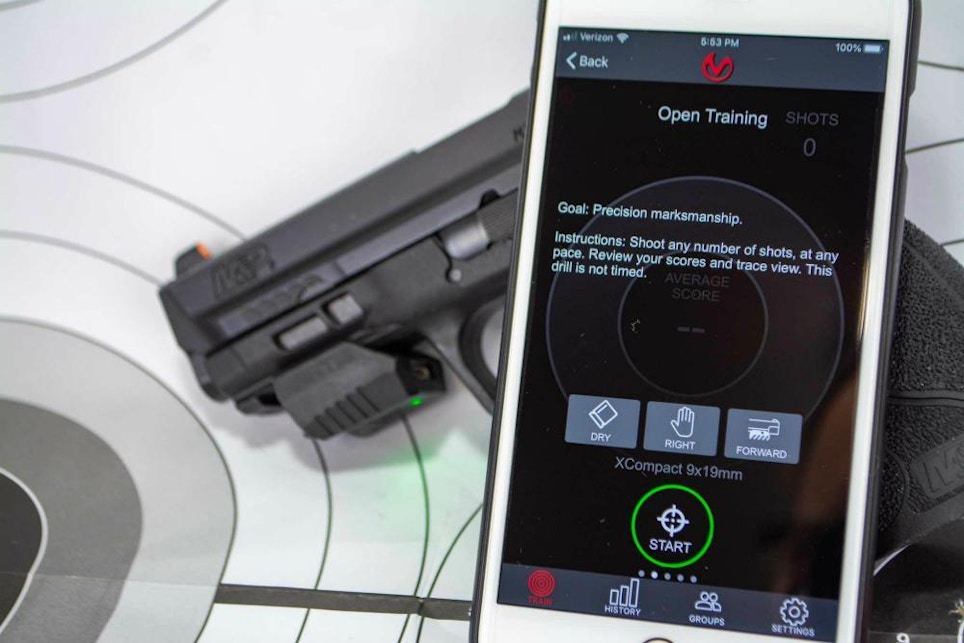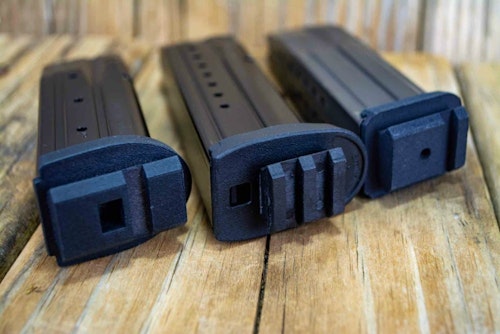
The Mantis X10 system consists of a motion sensor that mounts to the gun and a companion smartphone app that performs the analysis and displays and records results.
You probably tell your handgun customers to practice safe dry-fire routines at home if they want to become better shooters. You may even sell helpful accessories to make the practice less, well, boring. Snap caps are good extras to keep in stock. Laser cartridges and associated reactive targets are even better.
Until now, those have been the primary “tools” to help customers refine their basic trigger press skills. While trigger control is critically important, there are other skills not so easily developed. Recoil control and draw-to-fire sequences come to mind. Those have to be done at a live fire range, and many ranges don’t allow draws from the holster or the type of rapid fire that will help you refine your ability to control recoil and muzzle flip.
Sure, you can practice grip tension and “dry” draws in the comfort of home sweet home, but there’s no opportunity for precise feedback on improvement. And it’s boring enough to induce a coma.
Timing draws with a smartphone or stopwatch isn’t a great solution either. Getting a precise capture of start and stop times requires something more specialized like a shot timer or laser cartridge and smartphone app combination. Even if you invest in a way to measure the elapsed time, there’s no way to monitor the correctness of your form.
But technology is changing all that. Whether at home or at the range, there are tools that can provide detailed progress monitoring of many essential handgun shooting skills like trigger press, draws and recoil management.
Enter the new Mantis X10 Shooting Performance System.
How It Works
The Mantis X10 consists of a small tracking device about the size of two .45 ACP cartridges side by side and a companion smartphone app. It weighs next to nothing and snaps on to a standard Picatinny rail segment without need for tools. The purpose of the Mantis unit is to measure movement and timing of various activities.
Some combination of gyroscopic, sound and other motion sensors record events like gun movement and the sensation of a shot or click of a dry-fire trigger press. That doesn’t sound so impressive until you see the precision of what this unit can do with those capabilities. Measuring and capturing real-time data in milliseconds, the system can tell you everything that happens immediately before, during and after you break a shot — and much, much more.
What’s extra impressive is the sensitivity of all this tracking. The system picks up, records and analyzes movements too small and too fast for the human eye to detect, so in some ways, it’s better than a coach peering over your shoulder.

The system works in different shooting modes. It’s tough enough, and designed for live-fire use on the range. That’s an important point to share with your customers. It’s also sensitive enough to track dry-fire practice. It’ll sense the “click” of a dry-fire shot, so you can practice most of the included drills and scenarios in the comfort of your home. Last, but not least, it’s programmed to work with airguns.
The crop of ultra-realistic pistols from companies like Umarex and Sig Sauer are fantastic training guns that you can shoot in your garage or backyard. The system works equally well with those. You can also take advantage of “air only” practice by using an air pistol loaded with CO2 but no pellets. That configuration adds a reciprocating slide and a recoil sensation without the hassle of launching pellets all over the house. It’s living-room friendly.
Here are some things you can do with the system.
Technique and Quality
The basic analysis available with the original and current Mantis system is shot monitoring. The sensor waits to detect a live- or dry-fire trigger break. It then reviews its recorded movement of the gun right before, during and after the shot break. If you’re flinching just in advance of the shot, you’ll see it. If you’re overcompensating for anticipated recoil, you’ll see the dip and direction the muzzle moves after the shot.
For each shot, the system displays an aggregate score calculated from the aggregate before, during and after muzzle motion. It’s the quick and easy way to know if you executed a good trigger press without the moving the gun. A 90-plus score is great. A 30 or 50? Not so much.
That view also shows you a summarized circular graph that shows in which direction the muzzle moved for each shot. If you have a bad habit of jerking down and left, you’ll see it here. The system also presents detailed views of the exact muzzle travel path in space before, during and after the shot.
Of course, all of this is recorded forever, or at least until you delete it. That allows tracking of improvement over time.
Draw Speed
Holster draw analysis is a new capability delivered with the X10. This one feature alone makes the whole system worthwhile. Until now there has been no easy way to not only time, but see the exact path of the muzzle during a complete draw sequence. If your times are slow because you’re dragging the gun to one side or the other on the way out and up, you’ll see that represented pictorially.
The timing analysis itself is also discreet. Sure, the system will tell you that you went from “beep” to “fire” in 1.56 seconds. But it will also break down the durations within that overall time. The system records three stages of the draw.
- Grip: time from the start beep to when your hand grips the gun.
- Horizontal: time from the grip to when the gun is drawn and rotated to horizontal alignment.
- Shot: time from Horizontal to when the shot breaks.
This has proven to be a huge help for me. Seeing that I was spending too much time on the “grip” stage encouraged me to experiment with specific placement on my belt. A 2-inch movement of my rig reduced the time to clear my cover garment and get my hand on the gun by a good 1/5 of a second.
Draw Motion
While breaking down the component times of your draws can be a huge help to identify areas of improvement, seeing exactly what you did can make an even bigger impact. The system captures the muzzle path from holster to target and shows an overlay view of each motion in a shot string.
In a perfect draw scenario from a strong side hip holster, you should see a near vertical path of muzzle travel. If the gun is moving side to side and back to center or moving past the target and settling back on it, you’re wasting time.
Recoil Management
Another new function arguably beats the human eye — recoil control analysis. Since the system captures minute movements in milliseconds, it’ll tell you in excruciating detail exactly what happens after you fire a shot.
Shown in graphical form, again with all shots overlaid for a string, you’ll see not only the complete path of muzzle movement, but the time it takes the muzzle to get back on target after the shot breaks.
- Muzzle rise: the peak angular rise of the gun after the shot.
- Recovery time: time for the gun to return and stabilize to the original point of aim.
- Recoil angle: the angle to the left or right that the gun moved as it recoiled upward.
- Recoil width: the width of the loop formed by the upward and downward movement of the gun.
You’ll be amazed at how quickly you can improve your hold and time to fire a follow-up shot when you see exactly what’s happening in the recoil sequence.
Shotgun Swing?
Mantis isn’t just for pistols either. What’s the biggest problem that plagues new clay target shooters and hunters? Stopping the gun as the shot breaks. Mounting the Mantis to a shotgun will show you the complete swing path so you can see the efficiency of your overall swing and whether you’re following through with a moving barrel as you break the shot. The software allows you to record hits and misses so you can see how your technique relates to target success.
Mounting Options
The original MantisX was designed to mount to the forward rail of nearly any pistol. The company also offered magazine baseplate adapters facilitating use on pistols without a rail or revolvers. The new MantisX is noticeably smaller. You can still mount it on any forward rail, but its new reduced size makes it perfect for magazine baseplate mounting.
There are benefits to the magazine mount approach. The big one is that you can run drills of any kind using a holster. Whether you want to focus on a quality shot from the draw and measure trigger press smoothness, or run an analyzed holster draw motion, the magazine mount is the way to go.
Many of the adapter plates are gun specific. The company makes models for dozens of popular pistol models. If yours isn’t included in the list, there’s a universal adapter that attaches to the bottom of any magazine with double-sided stick tape. In testing several adapters, I’ve found it’s easier to just install the adapter baseplate and leave it in place on one of my spare magazines. It doesn’t impact function and adds minimal bulk, so having it on a magazine stuck in a carrier provides no downside.
The mounting options don’t stop there. Barrel adapters allow you to use to the Mantis with revolvers or rifles like the AR-15. A larger barrel adapter is suitable for shotgun use. There’s even a rubber strap adapter that provides a mount for competition rimfire and air pistols. If you shoot it, you should be able to attach the Mantis X10.
The Net-Net
Here’s a way that technology has been used to improve the quality of training. The detail level of reporting on a variety of core firearm skills provides the feedback needed to improve. On a more practical level, the tool and its immediate reporting make training more interesting, so it’s more likely your customers will use it.
Part of the beauty of the system is the intelligent division of labor. The tracking device itself records movement and data. The smartphone app is what performs the analysis and shows the reporting. That means that included drills and reports can be improved over time without having to replace the device itself. For example, new capabilities in the works that will appear in the app soon include analysis and tracking of skills like shooting on the move, rapid fire and multi-target performance reporting.
The Mantis X10 retails for $249.99. Be sure to inquire about their dealer programs.





